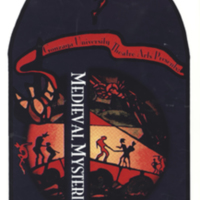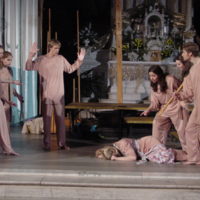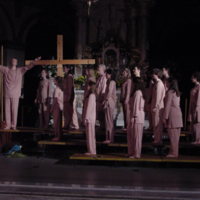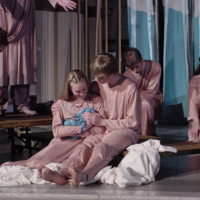2002 Medieval Mysteries
Show Overview:
Nineteen actors played over eighty roles to attempt to weave creation history into a visual tapestry of medieval poetry, comtemporary dance, and music. In interpretive efforts, artistic license was taken with gender-blind casting, while keeping the integrity of the stories in tact.
Since the medieval church played a pivotal role in rejuvenating our western tradition of drama, St. Aloysius Church was the ideal setting for the production--surrounded by the glorious artistic depictions in other forms to present stories of love, devotion, passion, fear, courage, and heavenly celebration.
Many scholars, artists, and designers helped to make the production a reality, bridging multiple departments of Gonzaga University, Whitworth College, and the St. Aloysius community.
Performances:
Cast & Artistic Staff:
More Items:
Click here to view photos associated with the 2002 production of Medieval Mysteries.
Click here to go to the full collection for the 2002 production.
Program Notes:
Between the 14th and 17th centuries in Britain, medieval mystery plays served a key role in society and influenced later writers including Shakespeare. Written mainly by clergy, these plays form cycles that narrate biblical history from the creation to the Day of Judgment. These plays became known as mystery plays because they were often performed by trade guilds and religious orders (the French word mistere means 'craft' or 'service').
Medieval institutions provided the mystery plays as a method of scriptural instruction for a largely illiterate audience. The mystery plays also served as entertainment and a dorum for social and political commentary. Trade guilds were able to advertise by performing plays with thematic, sometiems gruesome, advertising for their own guild. For example, the city of York's pinners (or nail-makers) produced the crucifixion play.
Scholars have determined that medieval staging practices varied widely. Due to the rainy British climate, the outdoor plays were performed during summer in conjunction with feast days, such as Pentecost or Trinity Sunday, and often ran from sunrise to sunset. Plays were performed in various other settings, ranging from churches, barns, and town squares to moving wagon caravans and open-air theatres.
The Medieval Mysteries is based upon a fifteenth-century manuscript known as the N-Town cycle. Among the surviving British mystery plays, the N-Town manuscript is unusual because it appears to be the compiled work of playwrights whose styles and emphases differed from one play to the next, and these plays were likely not produced by craft guilds. Some N-Town plays (suchas as the Passion) are longer than usual and may haven been performed individually. The N-Town plays also employed elaborate staging methods including symbolic masks and costuming and special effects using firecrackers, pulley systems, and trapdoors, staging devices that were later adapted by the Renaissance theatre and infact are still used.
Performance of the mystery plays continues largely by university groups, such as the University of Toronto. In 1998, over 500 actor and 30 theatre companies participated in a production of the complete York cycle. Recent productions of the N-Town plays included a performance by the University of Toronto in 1961 and another by Penn State in 1993. A four-hour version of [tonight's] production, edited by Douglas Sugano and directed by Ken Pickering, premiered in Birmingham, England in 1997. This show was the American premiere of The Medieval Mysteries.
Program Notes written by the Chaucer/Medieval Literature class - Whitworth College, Spring 2002 - Professor Doug Sugano




